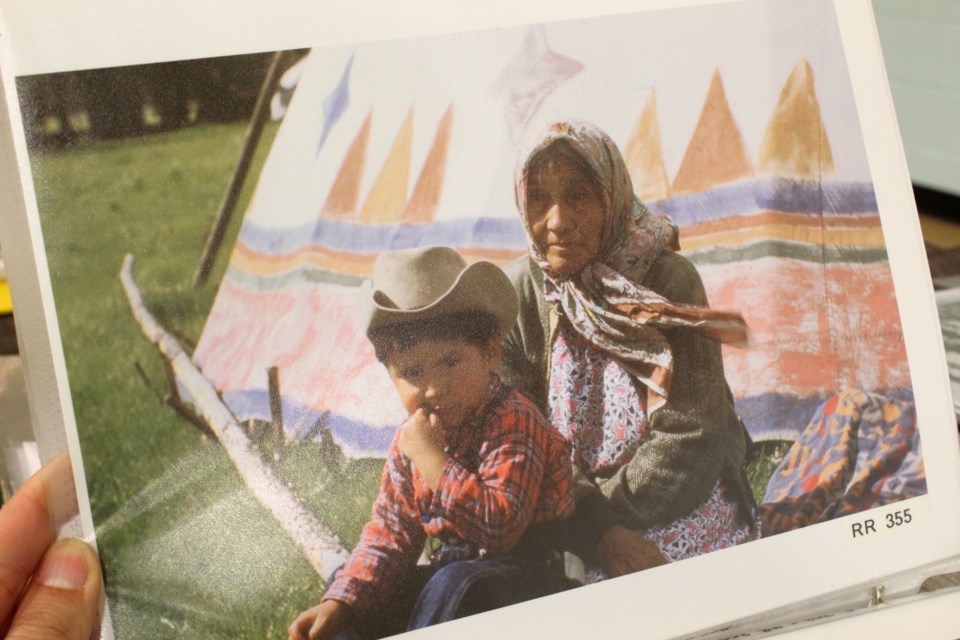STONEY NAKODA – Bernadette Poucette flipped through Whyte Museum archives, looking for photos of herself and her late sister.
“I used to be in the parade,” she tells the Whyte Museum organizers with a humble smile.
Holding the binder in her hands, attempting to recognize faces from more than 50 years ago, Poucette was just one of the many elders who attended the Recognizing Relations Project celebration in the old gym in the Morley town site Monday (Oct. 7) evening.
The project started four years ago, spearheaded by archives assistant and First Nations liaison Dagny Dubois. Recognizing Relations was initiated when Dubois was going through the archival photographs at the Whyte Museum realizing many of the pictures were missing names.
“When I first came to the archives, I noticed we have a lot of photographs of local Indigenous people, mostly from Banff Indian Day, which was in the late 1800s to 1970s period, [and] a lot of photos had no names,” Dubois said.
“A lot of times there was ‘Indian Warrior’ or ‘Chief’ – those were kind of the titles of photographs – so we felt it was important to get people's names attached to those, so we started reaching out to the community, interviewing elders and requesting names.”
As part of the Truth and Reconciliation Commission report, released in 2015 as a way to redress the legacy of residential school and advance the process of Canadian reconciliation, in the 94 Calls to Action, there is a whole section related to museums and archives.
Four calls to actions are outlined in the section, including establishing a dedicated national funding program for commemoration projects on the theme of reconciliation.
Wanting to change the colonial way history can be represented in museums, specifically with the historic "outdated and inappropriate" photo captions, the Stoney Nakoda Nation, consisting of three bands, Wesley, Chiniki and Bearspaw, was invited to work with the Whyte Museum archival staff to identify family members and friends, resulting in an abundance of proper identification.
“We have about 75 per cent of photos identified by name, close to 450 photographs and now we are going into a new phase where we are working with film more and got some other things lined up,” Dubois explained.
Showing archival movies on the wall of the old gym, elders sat behind the projector watching film clips of Banff Indian Days with Stoney people in their regalia.
“I wanted to see if I could see myself,” Poucette said looking at the film while also flipping through the several archive binders on the table.
Noting that she always used to wear a buckskin dress when attending the multi-day celebration in the 1970s, Poucette said she remembers having a grand time during the Banff Indian Day parades when the Stoneys used to ride horses down Banff’s main street to the Fairmont Hotel.
“Everyone would ride back and my horse would just take off and I’d just have to hang on,” she said with a laugh.
Poucette explained she used to have a picture of her late sister, who was a barrel racer, but said she lost all of the historic photos when her parent’s house burned down several years ago.
“My late sister won one time, but I lost the photo – I wanted to see if I could find any pictures of her,” she said.
Inviting elders and community members to continue the identification process on Monday evening, Dubois said the event was more about celebrating the four years of hard work and building relationships with the Nation.
“We’ve always tried to do group meetings and individual meetings with elders to show them what we have, but that always feels like work, so today is more about celebrating and we just want to thank the community for everything they’ve contributed and collaborated with us,” Dubois said.
The event attracted Nation members from all generations, including the Nakoda AV Club who were documenting the event.
“It’s a slow process to work together,” Jarret Twoyoungmen, 38, said in-between filming.
Discussing a time when Stoney people lost their history, the AV Club co-founder said there was a time when Stoney people didn’t know where they came from.
“The culture and the language ... we are trying to connect to our history and start over again. In schools we learn English and we learn about the Queen and the Prince, but it is good to be re-learning our history,” Twoyoungmen said.
Nation members were also offered to take a piece of history home, as the Whyte Museum staff gave community members the opportunity to request copies of the archives.
“We are trying to open up the collection to Stoney people because a lot of them have never seen these photographs of their own relatives,” Dubois said.
Poucette didn't say if she was able to find a photo of her sister at the end, but during one moment when watching the projection of the film on the old brick wall, her eyes lit up.
"One of them might be me," she said.
Visit the Whyte Museum website at whyte.org/recognizing-relations for more information on the Recognizing Relations project.




